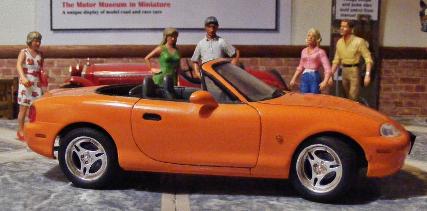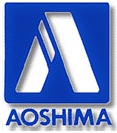
1998 Mazda MX-5 Roadster
With the demise of the British car industry the “affordable” sports cars market was left open for the world to fill. Austin-Healeys, Triumph’s Spitfire, MGs and their MGB and most notably the Lotus Elan were long gone by the 1980s and, largely, the rest of the world was ignoring this sector. The growing hole in the market was there for all to see as far back as 1976 and “Motor Trend magazine” reported Bob Hall, for one, could see what was happening. Hall was extremely knowledgeable about Japanese cars and recalls a conversation he had with Mazda's Kenichi Yamamoto. Asked for his opinion on what type of car Mazda should be looking to manufacture Hall’s answer was to fill the gap left by the retreating British manufacturer’s.
"I babbled ... how the ... simple, bugs-in-the-teeth, wind-in-the-hair, classically-British sports car doesn't exist anymore. I told Mr. Yamamoto that somebody should build (..an..) inexpensive roadster."
Some years later, while Bob Hall was in a product planning position with Mazda USA, he bumped into Kenichi Yamamoto, now chairman of Mazda Motors, again and the two relived their roadster conversation. In 1982 Yamamoto asked Hall to further investigate the idea further and Hall brought designer Mark Jordan into Mazda’s recently created Southern California design studio. Together they worked on all the different visual and mechanical elements to come up with clear concept for a light weight sports car. That concept was a small sporty two seat roadster, light weight and constrained only by the various countries motoring laws and safety requirements. It should be mechanically simply, with a standard front engine-rear wheel drive layout, reliable, but utterly modern in all areas.
Mazda was at that time running a new system of design concept development aimed at collecting the best ideas from all areas of Mazda’s company around the world. Called the "Offline 55" program Mazda looked at different “LWS” (Light Weight Sports), proposals from competing design studios in Japan and California. Paper presentations gave way to full-scale clay models in August 1984. Ideas such as a front wheel drive and mid-engined layout were considered but the Californian team’s FRD (front-engine, rear-wheel-drive layout), concept won out. Taking much inspiration from the 1960s Lotus Elan their proposal, codenamed Duo 101, was a clear successor to the British roadster’s that had been so favoured in America through the 1950s-60s; but it also had the capacity to have a hard top too, hence the “Duo” tag.
Development of a running prototype was entrusted to International Automotive Design (IAD) in Worthing, England. Using a Mazda Familia 1.4Ltr engine and other Mazda components from a variety of models, clothed in a fiberglass body, IAD produced a car, codenamed V705, for road testing. In August 1985 it was ready for shipping to California where it was tested on the roads around Santa Barbara. The results were good and the positive reaction led to the pre-production approval being given on the 18th of January 1986.
The final development phase, overseen by Toshihiko Hirai, saw five engineering/test mules being built by IAD in order for all the various development ideas and crash tests to be carried out. Final development was concluded in Japan where part of the design philosophy for the car was what the Japanese call “Jinba ittai”. This can be translated as rider (jin) and horse (ba) as one body (ittai). The inference speaks for itself and each area of the car was continually tweaked to remove any minor niggles, be they ergonomic, aesthetic or mechanical, until everyone was completely happy with the design.
Seven years of design and development were completed by 1989 and the MX-5 was ready for launch. Wondering what the MX-5 bit is all about, well it’s simple, Mazda, eXperimental project #5.
MX-5 Launch original car
The first generation (NA) MX-5 was presented to the world at the Chicago Auto Show of 1989. In North America the car was to be sold as the “Miata”, a word derives from Old High German and meaning "reward", and cost US$14,000 when it went on sale in May 1989. In Japan the car was known as the Eunos Roadster or the Mazda Roadster going on sale from the 1st of September 1989. Europe had to wait until 1990 for the MX-5 with the UK sale date being the 14th of March 1990; it cost a very reasonable £14,249.
In all cases the press loved it and the public clamoured to get a glimpse of the car. Sales quickly outstripped production as the new Mazda rejuvenated the simple sports car market. It was quite simply the right product launched at the right time. Lovers of the open top sports car driving the temperamental Alfa Romeos, Triumph’s and Fiats instantly fell in love with the reliable little car and whole new generation were introduced to the wind in your hair driving experience. Demand became so great and pre-order lists so long that several American dealerships increased their mark-up and still sold out!
Production of the First Generation (NA) MX-5 ran from May 1989 to 1997 and sold over 400,000 units. A midlife facelift gave the MX-5 a 1.8ltr engine option, larger brakes and a stronger rear differential. Truth was, the world already loved the car and Mazda were far from pandering to customer demands but following the Japanese mantra of improve, improve, improve
The original MX-5
The NA series car is recognizable by the pop-up headlights within the all-steel body shell. This monocoque construction had detachable front and rear subframes to aid servicing times while also adding to the rigidity. Weight was reduced a little by using light-weight aluminium for the bonnet and the beautiful slippery lines gave the little car a drag coefficient of Cd=0.38.
The front and rear subframes were also connected to each other by a longitudinal backbone truss called Powerplant Frame (PPF). This further rigid connection between the engine and the wheels with their independent double wishbone suspension all round, and anti-roll bars front and rear, provided even better performance and handling response. It equally gave reliable responsive feel under braking which was provided by all round disc brakes, behind alloy wheels or stamped steel wheels on the basic price model.
Powered by a 1.6ltr dual overhead cam inline four-cylinder engine the original NA series MX-5 could do 0-60mph in less than 9sec’s with a 114mph top speed. This performance was due electronic fuel injection, and ignition, ruled by a camshaft angle sensor instead of a distributor, allowing 114bhp @ 6500rpm. Mazda’s development team even tunes the exhaust note to have a classic sports car character.
Weighing in at just 940kg (2,070 lb) the MX-5 was indeed light even filled with fluids and loaded with all the options 980kg remains clearly in the light bracket. Compact but comfortable for even tall occupants with careful front-mid engine positioning a neutral 50:50 weight distribution was achieved. There was no wasted space in the handsome interior
The rigid form of the chassis and light weight gave fantastic throttle response, when translated through a 5-speed manual gearbox and coupled to the exceptional grip and stability the MX-5 presented a driving experience as good as it possibly could be.
As is usual with most cars development continued as the designers seek to maximise sales by meeting customer demands; and in response to different countries changing laws. Every tightening emissions standards and new safety requirements led to a serious upgrade in the engine department when the new BP-ZE 1.8 litre four-cylinder motor became part of the range. When an engine management computer was linked in a few years later the MX5 gained incredible performance and the ever-advancing techniques to lighten the car just kept adding to the driving fun.
1998-9
The continuous development program saw Mazda release the Second generation (NB) MX5 for the 1999 model year. The vehicle was actually previewed as early as the Tokyo Motor Show in October 1997 and debuted in showrooms from February 1998. This MKII version had fixed headlights and the hard top had a proper glass window. Further increases in engine power, the 1.8 now turned out 140bhp, and an even sleeker body with subtle curves gave the MX5 NB a muscular appearance to match its aggressive performance. One of the design team leader Tom Matano quipped :-
“we like to think of it as an MX5 that has been to the gym, adding muscle and tone”.
Although the new car was largely a response to more stringent safety requirements, such as the airbag in the Nardi steering wheel, it did have a new completely modernized interior, more refined and including the option of a six-speed manual gearbox, the designers achieved their ambition of a car fit for the 21st century. Packaged in dimensions almost the same as the first generation MX5 this new version still retained the essence of the great sportscars it took its DNA from. It was a runaway success capable of 130mph and a 0-62mph time of 7.8sec.
Like the original MX5 the NB series also had a series of upgrades and make-overs. Variable valve timing meant the creation of a slight power bulge in 2001. Larger brakes, needing larger 16″ wheels, also gave the car more stopping power. Various colour options came and went, and there was even a short-lived fixed roof coupe version. A large number of “Special Edition” models, with everything from electric central locking and immobilisers to Bose speakers and Bilstein shock absorbers, were complimented by “MazdaSpeed” performance versions featuring turbocharging and an upgraded suspension system fitted with even larger, wider, 17″ tyres. Everything Mazda did with the MX5 just kept coming up golden.
Production numbers and details
The MX5 is now the world’s official best-selling convertible. Just a few short years after the first sale date of 1st of September 1989 production was already over 250,000 units (9th of November 1992). The half a million mark was reached on the 8th of February 1999 and three quarters of a million by March 2004. In January 2007 the 800,000th car was produced and 900,000th target was hit in February 2011.
Already in the Guinness Book of World Records for its sales achievements the publishers of that book were repeatedly revising the facts. In April 2016 total production, across all models and five design generations, topped the one million figure. To date, the MX5 remains the world’s most successful sports car design.
Conclusion
After reviving the market for open top two-seater sports cars Mazda continued to lead the way forcing its rivals, like BMW (Z1) and Porsche (Boxster), to review their model ranges and try to catch up. Conceptual, and even spiritual, successor to those classic British sportscars of the ’50 and ‘60s the MX5 was as wonderful a car as you might expect from the Japanese manufacturers.
Bringing a new generation the thrills of affordable “wind in the hair” performance motoring, the MX5 also gave veteran sports car fans a reliable everyday replacement for their aging, and their predictably unreliable, Alfas, Triumphs, and MGs. It was simply everything it was intended to be and did everything owners wanted it to do. It was an instant classic and spawned multiple racing categories around the world including the Ma5da series in the UK, now Max5, and the Sports Car Club of America's Solo2 autocross and Spec Miata race series.
The list of accolades is long and impressive spanning decades from the 1990 Automobile Magazine "Automobile of the Year" to the 2016 “World Car of the Year” at the World Car Awards (UK), but perhaps the best accolade comes from Jeremy Clarkson, a notoriously difficult to please, and highly controversial British automotive critic, who wrote the following in 2009.
“The fact is that if you want a sports car, the MX-5 is perfect. Nothing on the road will give you better value. Nothing will give you so much fun. The only reason I’m giving it five stars is because I can’t give it fourteen.”
‘Nuff said.











Aoshima kit # 020999 of the Mazda MX-5 roadster is a nice kit and captures the subject well. Aoshima went on to release kit # 021958, titled “Lightweight Sports Mazda Miata MX-5”, in 1998 and the ostensibly the same base kit has been re-released several times with different decals and additional parts to give other versions of the car.
Aoshima was originally an aeroplane research institute set up by Jiro Aoshima in 1923. Based in Shizuoka, Japan, the company moved in manufacturing wooden model kits of aircraft in 1929. As time progress the Aoshima model company grew and, building on the success of their wooden model kits, eventually transferred to injection plastic model kits.
Whatever the medium Aoshima has always been known for attention to detail, quality and customer satisfaction. As the company reached further around the world the need for an extended product range saw Aoshima add military and civilian vehicles to their catalogue.
In recent years (from around 2012 onwards) Aoshima has really emerged as a competitor to Tamiya for subject range and kit engineering quality. Their range of automotive models has grown considerably and become increasingly available around the world through an increasing number of retail outlets and, of course, the internet. Current president, Mr. Daisuke Aoshima, is keen to see the company continue to grow and to expand across many hobby activities beyond scale model making.
Rod built this model in October 2001. It is painted with Halfords acrylic car spray paints and a variety of Humbrol enamels and Revell and Citadel acrylic paints and ink washes. Tamiya ‘clear’ red and orange are very useful for rear lights and indicators.
Sadly, transporting models to shows and events does lead to damage to models. This car suffered a broken axle so we have also put in the photo’s a copy of the repair job that resulted in the wheel still being able to rotate despite some parts having been lost somewhere along the way……… Clever Rod, eh?
